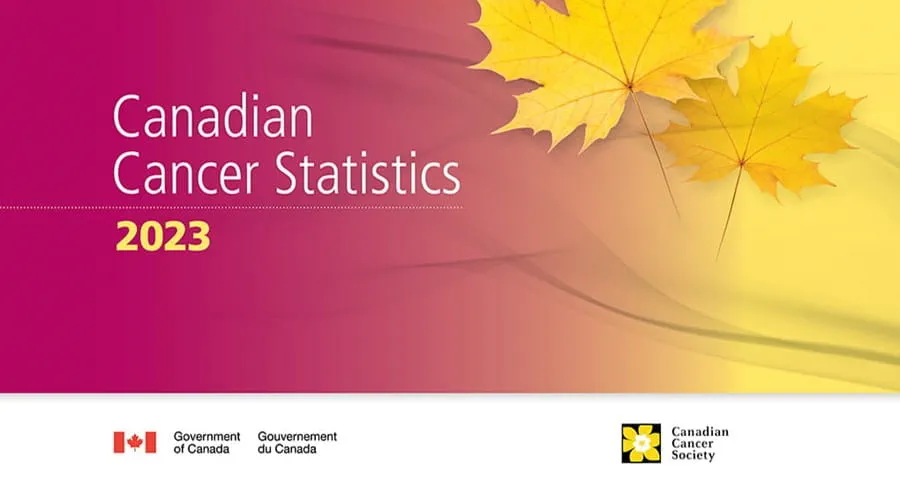Cancer statistics at a glance
Cancer statistics tell us how many people in Canada are diagnosed with and die from cancer each year. They show us trends in new cancer cases and cancer deaths. Cancer statistics also tell us the likelihood of surviving a cancer diagnosis and the percentage of people who are alive a certain number of years after a cancer diagnosis.
Canadian provinces and territories collect data on cancer cases and cancer deaths. These data are combined to give us a picture of how cancer affects people across Canada.
Statistics are an important part of healthcare planning. They also help us measure the success of cancer care and control.
This page provides some cancer statistics at a glance, including incidence and mortality by sex, age group and geographic region.
(Please note that these statistics are reported by sex assigned at birth, classified according to the standard used at Statistics Canada as male or female. Data relating to gender identity were unavailable. These statistics include an unknown number of intersex, transgender, non-binary and gender-diverse people.)
Incidence and mortality
Incidence is the number of new cases of cancer. Mortality is the number of deaths due to cancer. Researchers use the most up-to-date data available and statistical methods to estimate the number of new cancer cases and deaths for the current year.
Researchers estimated that there would be 247,100 new cancer cases and 88,100 cancer deaths in Canada in 2024. (The number of estimated new cases does not include non-melanoma skin cancer cases.)
It is estimated that an average of 675 people in Canada would be diagnosed with cancer and 241 people would die from cancer each day in 2024.
Cancer incidence for males and females in Canada in 2024
The interactive graph below shows the expected distribution of new cancer cases in males and females in 2024.
It was estimated that in 2024:
- 127,100 males and 120,000 females would be diagnosed with cancer.
- Prostate cancer would account for about one-fifth (22%) of all new cancer cases in males.
- Breast cancer would account for one-quarter (25%) of all new cancer cases in females.
- Lung and bronchus (lung) cancer would be the second most common cancer in both males (after prostate) and females (after breast).
- A greater number of females (17,300) than males (14,800) would be diagnosed with lung cancer.
You can use the interactive graphs and maps that follow to explore more cancer statistics. They include more statistics about specific cancer types and statistics for males, females or both sexes combined. For some interactive graphs, you can get statistics for different age groups. Feel free to explore the different filters for the statistics available.
Distribution of Projected Cancer Cases in Canada, 2024
Cancer mortality for males and females in Canada in 2024
The interactive graph below shows the expected distribution of cancer deaths in males and females in 2024.
It was estimated that in 2024:
- 47,300 males and 40,800 females would die from cancer.
- Lung cancer would be the leading cause of cancer death in both males (10,900 deaths) and females (9,800 deaths), accounting for almost one-quarter of all cancer deaths.
Distribution of Projected Cancer Deaths, Canada, 2024
Cancer incidence and mortality by age
Cancer can occur at any age, but it mostly affects people who are older than 50 years of age. In Canada, 9 in 10 cancer cases are diagnosed in people older than 50.
The interactive graphs that follow show the percentage of cancer cases and deaths by age group based on data from 2017 to 2019. You can also display cancer incidence and mortality rates by age group. As shown in the graph:
- The highest percentage of new cancer cases was diagnosed between the ages of 65 and 74 years.
- Between the ages of 15 and 59 years, rates of cancer were higher among females than males.
- The number of cancer deaths and mortality rates increase dramatically with age.
Percentage of Cancer Cases for All Cancers by Age Group and Sex, Canada 2017-2019
Percentage of Cancer Deaths for All Cancers by Age Group and Sex, Canada, 2018-2020
Cancer incidence and mortality by geographic region
The maps that follow show the expected distribution of cancer cases and deaths across Canada in 2024. The following are estimates for 2024:
- In general, it is expected that cancer incidence rates for 2024 will be highest in eastern and central Canada.
- It is expected that mortality rates for all cancers combined would generally be higher in the East and lower in the West.
There are differences across Canada for specific cancers. It is estimated that:
- Colorectal cancer incidence and mortality rates would be highest in Newfoundland and Labrador for both males and females.
- Lung cancer incidence and mortality rates would generally be highest in Quebec and the Atlantic provinces.
Cancer incidence rates vary between provinces and territories because of differences in risks (including behaviours and exposures), diagnostic practices and data collection. Similarly, cancer mortality rates vary because of regional differences in incidence. Mortality rates may also vary due to differences in access to and outcomes of cancer services, such as screening, diagnosis, treatment and follow-up.
Projected Cancer Cases by Geographic Region, Canada, 2024
Projected Cancer Deaths by Geographic Region, Canada, 2024
Survival
There are many different ways to measure and report cancer survival statistics. Net survival is an estimate of the percentage of people who are alive at some point in time after their cancer diagnosis, accounting for other possible causes of death. Most survival statistics are reported for a specific time period, usually 5 years.
Based on data from 2015 to 2017, the predicted 5-year net survival for all cancers combined was 64%. This means that about 64% of people are expected to survive at least 5 years after their cancer diagnosis. This is up from 55% in the early 1990s. In the 1940s, survival was about 25%.
Survival rates vary from low to high depending on the type of cancer. Based on 2015 to 2017 data:
- The 5-year net survival rate for lung cancer is low (22%).
- The 5-year net survival rate for colorectal cancer is about average (67%).
- The 5-year net survival rate is high for prostate cancer (91%) and breast cancer (89%).
Survival varies by stage at diagnosis. The study “Five-year cancer survival by stage at diagnosis in Canada” provided the first 5-year stage-specific net cancer survival estimates in Canada. Based on 2015 to 2017 data:
- For the most commonly diagnosed cancers in Canada, the 5-year net survival decreased as the stage at diagnosis increased.
- For most of the cancers studied (breast, prostate, colon and rectal), survival was better than 90% when they were diagnosed at stage 1. Survival for stage 1 lung cancer was 62%.
- Cases diagnosed at stage 3 had higher survival than those diagnosed at stage 4.
5-year stage-specific net survival for selected cancers, ages 15-99, by sex, Canada (excluding Quebec), 2010-2017
Canadian Cancer Statistics resources
Canadian Cancer Statistics provides comprehensive surveillance statistics on cancer in Canada. The full publication is produced every second year and includes detailed statistics on incidence, mortality and survival by sex, age group, geographic region and time period for more than 20 cancer types. In alternate years, 2 publications are released—a special report on important issues in cancer control and a publication with current-year projected estimates of incidence and mortality.
Canadian Cancer Statistics is developed by the Canadian Cancer Statistics Advisory Committee in collaboration with the Canadian Cancer Society, Statistics Canada and the Public Health Agency of Canada, with data provided by the provincial and territorial cancer registries through the Canadian Cancer Registry.
The Canadian Cancer Statistics Dashboard provides user-friendly and interactive visualizations of the data presented in the Canadian Cancer Statistics publications. It includes up-to-date projected estimates of cancer incidence and mortality by age, sex, geographic region and over time.
The dashboard was developed by the research team led by Dr Darren Brenner and Dr Tamer Jarada at the University of Calgary and the Charbonneau Cancer Institute, with funding from the Canadian Cancer Society. The dashboard leverages the efforts and cancer data of the provincial and territorial cancer registries provided through the Canadian Cancer Registry.


